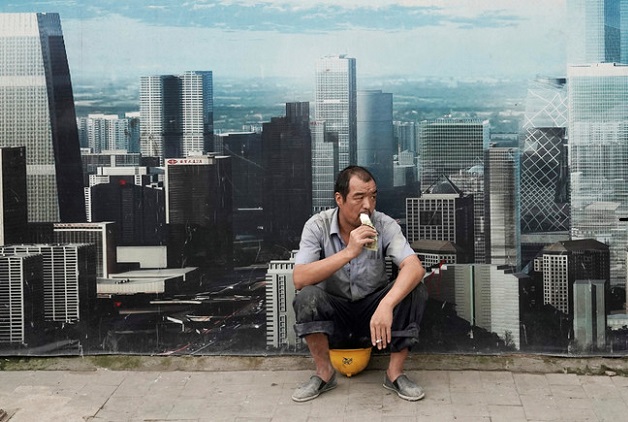Why Migrant Workers are the Key to Asia’s Green Cities of the Future

Source:REUTERS/Jason Lee
Building Asia's green cities will change more than skylines. It can unlock social mobility, job opportunities and skills development.
Views
Why Migrant Workers are the Key to Asia’s Green Cities of the Future
By Benjamin Pinneyweb only
Building Asia’s green cities of the future is about more than energy efficiency - it can drive a virtuous cycle of economic growth and restructuring, as low-skilled jobs on large construction sites provide income opportunities for millions of migrants.
On-the-job training can equip these labourers to build efficiently — and to build buildings and urban systems that operate more efficiently. Over time, formerly itinerant workers will be able to settle as residents of the cities they helped to build, and to move from having a toehold on the economic ladder into the consuming, urban middle classes.
This virtuous cycle of migration, construction and sustainable urbanization is not just wishful thinking but a necessity if Asia’s countries and cities are to grow sustainably. If, as widely projected, 70% of the world’s population will live in cities by 2030 and if we want cities to be economically, socially and ecologically viable places, we need to create the conditions for this cycle.
Across Asia, this translates into enabling more than 100,000 new urbanites each day, which requires supporting mobility, upskilling and economic opportunities for hundreds of millions of migrant construction workers over the next decade.
If we fail, it will not be down to a lack of technical or economic capacity. The building and information systems, the planning know-how and the financing mechanisms to realize large-scale green development exist today. It is social and institutional conditions that need to be reevaluated and reformed.
If we are to will this necessary future into reality, we need to balance policy objectives for the performance of buildings with those for employment. Successful large-scale urbanization depends on a simple relationship: innovations in building standards and in labour market management. As a combination of increasing design sophistication to meet green requirements and ‘smart’ technologies embedded in buildings creates new demands for construction capabilities, traditional forms of knowledge and skill transfer need to be reinforced.
Top priorities
Three aspects of the construction labour market matter especially in rapidly urbanizing Asia.
First, cities and regions need to recognize urbanization as an exercise in very large-scale labour mobilization. Developing the resources to build efficient buildings and infrastructure is a public good. No single construction project or employer can fully capture the lifetime value of the skills required to build green buildings — and skills gained on one project quickly scatter as labourers move on to the next job site. Without public investment to develop construction labour, social outcomes will not be optimal.
Second, the construction industry’s potential as an employer in emerging markets exists partly because labour market entry barriers are low. Mandatory certifications can improve workers’ productivity, but to the detriment of the industry’s absorptive capacity. Premature or excessive regulation of a trade tends to push labour into informal markets. In markets where construction work is as important to employment as to economic productivity, incentives for building performance that pull desired skills make more sense than erecting barriers to labour market participation.
Lastly, the central role that labour brokers play in clearing markets for construction workers can be harnessed to upskilling. The labour boss is known by many terms — mestry in parts of India, kepala in Malaysia, baogongtou in China, and so on. These brokers use ethnic, family and village ties to recruit labourers from rural or disadvantaged communities and connect them with temporary work. Such go-betweens also serve a knowledge-management function.
Home communities are the basis for skill and knowledge transfer as construction activity moves between geographic markets.
Upskilling to meet increasingly sophisticated construction requirements and technologies can enlist these brokers and their communities.
Johnson Controls is proud to have just opened a new headquarters in Shanghai that is among the most green-certified buildings in Asia. We are proud to contribute to the training and development of the people building green facilities across Asia. At the same time, both in managing the development of our own building and supporting customer projects, we are keenly aware that more holistic investments than any one firm can make will be needed to build the green buildings, green cities and inclusive, skilled workforces that the future requires.
The future of urban Asia is under construction today. A large proportion of the people digging foundations, building formwork, carrying materials, installing insulating panels and determining whether buildings and infrastructure achieve their designed performance are low-skilled migrant workers. Together, we must clearly define rules and regulations around construction and construction labour markets to enable the sustainability of future-built environments. As an essential part of this, we also need to build and celebrate the capabilities of the workers who are building the future. By joining labour market policies, the existing fabric of labour relations in construction, and building efficiency regulations, Asia’s green future may not be as far away as we think.
Additional Reading
♦ 8 Things You Need to Know about India’s Economy
♦ The One Belt, One Road Initiative: What Is China Really Up To?
♦ The Battle for the Mekong River
Original content can be found at the website of World Economic Forum.
♦ Why migrant workers are the key to Asia’s green cities of the future
This article is reproduced under the permission of World Economic Forum (WEF) and terms of Creative Commons Attribution-NonCommercial-NoDerivs 4.0 Unported License (“CCPL”). It presents the opinion or perspective of the original author / organization, which does not represent the standpoint of CommonWealth magazine.







